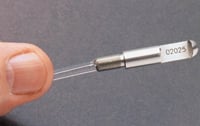It's bad enough dealing with ice on the ground, but ice on an aircraft is definitely bad news. Detecting ice when it forms is important, if only to alert the pilot before the ice starts affecting the flying behavior of the aircraft.
 |
New Avionics Corp. has designed a remote-sensing ice detector probe that detects ice with a sensitivity of 0.001 in. and alerts pilots to the presence of ice on the plane before it becomes an in-flight hazard. The tiny optical ice-detecting transducer probe can be placed up to 1 m away from its electronics. It senses the first 0.001 in. of airframe icing when aloft. Because it senses icing so early, it provides a standard for known icing conditions, advising the pilot to activate the anti-icing system, disengage the autopilot, activate engine heat, climb, descend, or turn around. Its small size (0.25 in. dia. by 1.5 in. long) means it can be used for onboard ice detection in unmanned aerial vehicles; added to antennas, altimeters, and Pitot tubes or other aircraft equipment; or added to data recorders to provide icing profile measurements.
Contact Richard Hackmeister, New Avionics Corp., Ft. Lauderdale, FL, 954-568-1991, [email protected], www.newavionics.com)